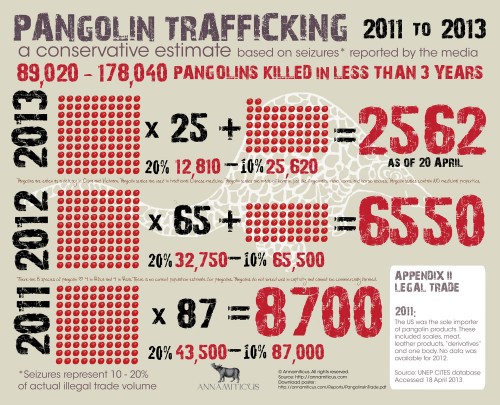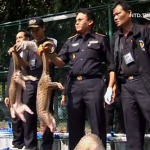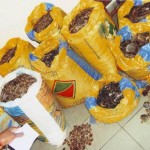
A conservative estimate of pangolin trafficking from 2011 through April 20th, 2013, suggests that more than 100,000 of these small mammals could have been killed in less than three years.
Since most illegal wildlife trade is undetected, we based our estimate on seizures reported by the media for the 28-month period — a total of 17,812 pangolins, accounting for scales and parts. Considering that seizures generally represent only 10 to 20 percent of the actual illegal trade volume, we estimate that between 89,020 and 178,040 pangolins were destined for the black market.
So far this year, we found a total of 2,562 pangolins accounted for in media reports, including the seizure of 11 kg of scales in India and the 2,000 pangolins discovered in the cargo hold of a Chinese fishing vessel which ran aground in the Philippines. In March 2013, more than 200 pangolins were confiscated: Malaysia’s Department of Wildlife and National Parks seized 133 pangolins at Kuala Lumpur International Airport and the Thai navy confiscated 104 pangolins. Indonesian authorities seized 128 pangolins in North Sumatra in February and 189 pangolin skins in Jakarta in January. These seizures indicate that between 12,810 and 25,620 pangolins were already headed for illegal markets in 2013.
In 2012, at least 6,550 pangolins were intercepted. Pangolin seizures were reported in China, India, Indonesia, Laos, Malaysia, Nepal, Pakistan, Philippines, Sri Lanka, Thailand, Uganda, Vietnam and Zimbabwe. Using the seizure figures as a guide, 32,750 to 65,500 pangolins were illegally traded in 2012.
The year 2011 was a deadly one, with a total of at least 8,700 pangolins reportedly seized across Angola, Cambodia, Cameroon, China, France, India, Indonesia, Malaysia, Myanmar, Mozambique, Nepal, Sri Lanka, Thailand and Vietnam. Somewhere between 43,500 and 87,000 pangolins were trafficked in 2011.
Pangolins are eaten as a delicacy in China and Vietnam; most illegal shipments of pangolins are destined for China. Pangolin scales are used in traditional Chinese medicine, although there are no proven health benefits to consuming pangolin scales.
- View the 1500 x 1215px Pangolin Trafficking 2011 — 2013 infographic (full-size poster coming soon!)
We note that these numbers are subject to change as more information becomes available.


![Pangolin Trafficking: 2011 to August 2013 [Infographic]](https://annamiticus.com/wp-content/uploads/2013/08/PangolinsInTrade2011thruAugust2013-150x150.jpg)

